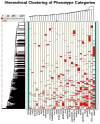Mining OMIM for insight into complex diseases
- PMID: 15360913
- PMCID: PMC2883183
Mining OMIM for insight into complex diseases
Abstract
Understanding clinical phenotypes through their corresponding genotypes is one of the principal goals of genetic research. Though achieving this goal is relatively simple with single gene syndromes, more complex diseases often consist of varied clinical phenotypes that may be the result of interactions among multiple genetic loci. Microarray technology has brought the phenotype -genotype relationship to the molecular level, using differently behaving cancers, for example, as the basis for comparing patterns of gene expression. With this feasibility study, we attempted to use similar methods of analysis at the clinical level, in order to evaluate our hypothesis that the clustering of clinical phenotypes would provide information that would be useful in elucidating their underlying genotypes. Because of its breadth of content and detailed descriptions, we used OMIM as our source material for phenotypic and genetic information. After processing the source material, we then performed self-organizing map and hierarchical clustering analysis on representative diseases by phenotypic category. Through pre-determined queries over this analysis, we made two findings of potential clinical significance, one concerning diabetes and another concerning progressive neurologic diseases. Our methods provide a formal approach to analyzing phenotypes among diverse diseases, and may help indicate fruitful areas for further research into their underlying genetic causes.
References
-
- Phillips TJ, Belknap JK. Complex-trait genetics: emergence of multivariate strategies. Nature Reviews Neuroscience. 2002;3:478–485. - PubMed
-
- Kanehisa M, Bork P. Bioinformatics in the post-sequence era. Nature Genetics. 2003;33:S305–S310. - PubMed
-
- Perou CM, Sorlie T, Eisen MB, et al. Molecular portraits of human breast tumours. Nature. 2000;406:747–52. - PubMed
-
- Baldini A. DiGeorge syndrome: the use of model organisms to dissect complex genetics. Human Molecular Genetics. 2002;11:2363–69. - PubMed
Publication types
MeSH terms
Grants and funding
LinkOut - more resources
Full Text Sources
Medical


